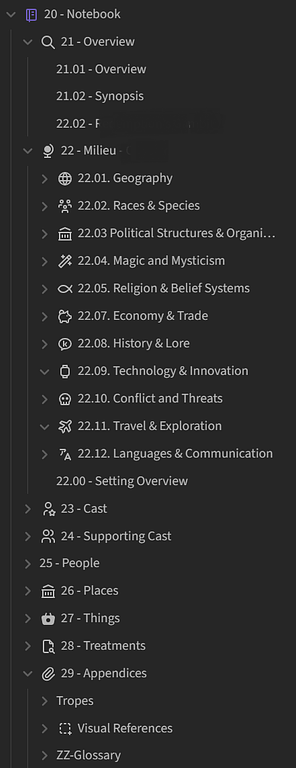An Eclipsed Week in a Lean World
I hope this update finds you well. The Eclipse of 2024 nearly brought an end to all mankind. This was my third eclipse, though there might have been a fourth that I don’t remember. I remember the 1984 eclipse in part because it happened around the time of my Papaw’s death. The last one was just a few years ago when we were moving between homes.
What have I been up to? A new series idea. The reason I mentioned a series notebook last week was because I started tinkering with a dark fantasy setting. Since there aren’t different grades of dark fantasy, and since this series might not be dark enough, I’m thinking it will be more milk chocolate fantasy (as opposed to dark chocolate). There, I’ve made it a thing.
Okay, maybe I should have thought about a flatter image. But if you’re curious how I organize my thoughts, that’s as good a graphic as I can share. Don’t let the length of it fool you, there are a lot of blanks in the outline. But sections like 22.04 and 22.08 are well developed. 21.01-03 are summaries, with 21.03 (mis-identified and obfuscated) being the placeholder for a four-book outline.

I spent a lot of time this past week using ChatGPT and Claude AI with research. I could spend my days trolling through Wikipedia, which is its own time suck. Or, I could ask AI to give me a summary in a format that was useful to worldbuilding. Having once tinkered with developing a tabletop role-playing game, I incorporated the magic system. I used AI to strip away the game mechanics and help me think out implications of the system as it relates to storytelling. Since I am basing my languages off of real-world languages, I used AI to help me define place names and create a set of character names I could use that were consistent. The big take away is that AI does a great job of making things suck unless you take a very active role in what it spits out.
One thing it is good at is summarizing what I created. This weekend, I roughed out the plot treatment for the first book (using the Lean Method below). Then I had AI condense the treatment to a one-page synopsis and summary. I then had it pick out the key characters as I defined in the treatment, and put them into a character sketch. It did well when I gave it tedious work like that; cloze exercises. This might be the sort of work handed off to an assistant, but no assistant would do this kind of work alone and I can’t justify one on my author’s income.
After ten days, where am I? There is enough of the setting to let me rough out the first four books. I have enough on the core characters to go beyond the first book. But I also have the full treatment for the first book. That took me most of Saturday and Sunday. This week, I hope to continue working the other treatments so I have a good idea of the entire series. Not that it matters much. I’ve had characters that mocked my attempt to structure them. One character changed the entire plotline of a novel because he wasn’t happy with what I wanted for him.
Another series of mine, with two books written and release ready, is organized in much the same way. We went to the Outer Banks (not the ocean side due to my long-standing feud with the Atlantic). That week, I covered about as much ground as I did this week. In the following months, I did supplemental research as it is an alternative history series.
For my fellow authors, I wanted to share a bit more about how I outline books. The 8-segment model, popularized by David Lean, is a storytelling structure that divides a narrative into eight distinct parts. Each segment serves a specific purpose in the overall plot. Each one is a reel long so that a 15-minute reel becomes a two-hour movie. If you’ve read enough about storytelling, this is not original.
Here’s my summary of the eight segments as they apply to movies and novels. Maybe you will find it helpful.
- Status Quo: Introduce the main character and their world, establishing the current state of affairs before the story begins.
- Inciting Incident: An event that disrupts the status quo and sets the story in motion, forcing the protagonist to take action.
- Predicament: The protagonist faces a problem or challenge that they must overcome, often leading to a difficult decision.
- Midpoint: A major turning point in the story, where the protagonist experiences a significant change or revelation that alters their course.
- Reversal: An unexpected twist or setback that challenges the protagonist’s progress and raises the stakes.
- Crisis: The protagonist faces their greatest challenge yet, often confronting their own weaknesses or the story’s central conflict.
- Climax: The highest point of tension, where the protagonist must make a final push to overcome the obstacle and achieve their goal.
- Resolution: The aftermath of the climax, where the story’s threads are tied up, and the protagonist’s journey comes to a satisfying conclusion.
–
Ben Wilson, Author